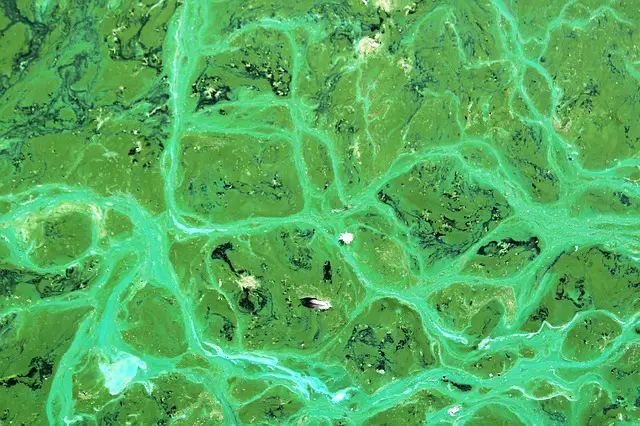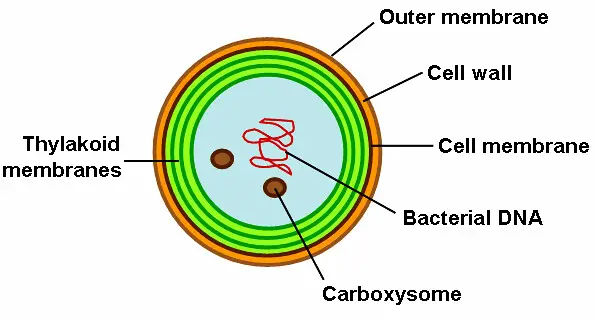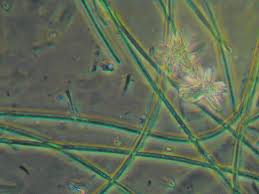Photosynthetic Bacteria
** Definition/Examples, Vs Chemosynthetic Bacteria
Definition
Essentially, photosynthetic bacteria are prokaryotes that are capable of converting light energy (from the sun) into chemical energy through a process known as photosynthesis.
They are also classified as photoautotrophs because they can make their own energy using inorganic material from their surroundings. For this reason, they are not fully dependent on other organisms of organic material for energy.
There are different types of photosynthetic bacteria that are widely distributed in both terrestrial and aquatic environments (they can be found in soil, oceans, sludge, and lakes, etc.). In these habitats, (e.g. in marine habitats where the most abundant photosynthetic bacteria can be found), these organisms also act as primary producers and thus play a crucial role in the food chain.
* Photosynthetic bacteria also play a central role in carbon fixation as well as oxygen production.
Examples
As mentioned, there are different types of bacteria capable of photosynthesis.
Generally, they are divided into five (5) main groups that include:
Cyanobacteria
Also known as "blue-green algae", Cyanobacteria are Gram-negative bacteria commonly found in aquatic ecosystems. Although more than 2,000 species in the phylum Cyanobacteria have been described, it's estimated that there are over 6,000 species distributed in different habitats across the globe.
Because of the ability of some of these species to fix nitrogen, they can be found in a symbiotic relationship with various plants and lichens. However, many other species can be found living freely in water and soil.
Photosynthesis in Cyanobacteria
Like plants and algae, photosynthesis in Cyanobacteria is characterized by the release of oxygen. This type of photosynthesis is known as oxygenic photosynthesis. These bacteria are therefore classified as oxygenic phototrophs. However, they have also been shown to exhibit diversity and flexibility in their pigmentation.
While the majority of species contain Chl a, phycocyanin, and allophycocyanin (as well as some carotenoids), other species contain phycoerythrin while others like Prochlorococcus and Acaryochloris species contain Chl b and Chl d respectively. In some species, studies have shown Chl a to be transformed into Chl b with changes in some environmental conditions.
As is the case with other oxygenic phototrophs, photosynthesis in Cyanobacteria involves linear transfer of electrons. Here, electrons are transferred from water to NADP (Nicotinamide adenine dinucleotide phosphate) through the PSI and PSII photosystems resulting in the production of oxygen and ATP.
In general, photosynthesis in Cyanobacteria involves the following steps:
· Light energy is absorbed by the PSII system located on the surface of Cyanobacteria thylakoid - This splits water releasing oxygen and electrons
· Electrons from the first step are then transferred by plastoquinone (PQ- an isoprenoid quinone molecule involved in the electron transport chain) into the thylakoid membrane to the cyt (cytochrome) b6f complex
· From the b6f complex, these electrons are transferred to the PSI (Photosystem I) by plastocyanin (PC) through the thylakoid lumen
· In PSI, electrons are excited by light for a second time before reducing NADP+
· Protons produced during this process enter the thylakoid lumen where they promote the synthesis of ATP by the enzyme ATP synthase. On the other hand, electrons from PSI reenter the PQ pool which contributes to the production of more ATP rather than NADPH
Some examples of Cyanobacteria species include:
· Synechococcus elongatus
· Microcystis aeruginosis
· Nostoc punctiforme
· Anabaena variabilis
· Arthrospira platensis
Proteobacteria (purple bacteria)
The second group of photosynthetic bacteria belongs to the phylum Proteobacteria. Like Cyanobacteria, Proteobacteria are Gram-negative bacteria widely distributed across the globe. However, unlike Cyanobacteria, this phylum contains many pathogenic genera including Salmonella, , Escherichia, and Vibrio.
* According to studies, there are over 460 genera within the Phylum Proteobacteria with over 1,600 species within five (5) main classes; Gammaproteobacteria, Alphaproteobacteria, Epsilonproteobacteria, Betaproteobacteria, and Deltaproteobacteria.
Photosynthesis in Proteobacteria
Unlike Cyanobacteria, which are oxygenic photosynthetic bacteria, members of the phylum Proteobacteria are mostly associated with anoxygenic photosynthesis. However, some aerobic species have been identified in different habitats across the world.
Compared to plants and some other photosynthetic bacteria (e.g. Cyanobacteria), Purple bacteria capable of photosynthesis have been shown to only consist of a single photosystem (bacteriochlorophyll) within the intracellular membrane. Because of the simplicity of the photosynthetic device among these bacteria, they are unable to split water to release oxygen.
In anaerobic conditions, simple organic acids or hydrogen disulfide are often used as electron donors. Electrons obtained from these sources are then transported through various electron carriers before protons are pumped through the membrane in order to produce a proton gradient. The gradient is then used by the enzyme ATP synthase to generate ATP.
* Whereas purple sulfur bacteria use sulfide and hydrogen as electron donors, non-sulfur bacteria generally depend on organic carbon compounds.
Some examples of photosynthetic Proteobacteria species include:
- Rhodobacter sphaeroides
- Rhodobacter capsulatus
- Chromatium okenii
- Rhodopseudomonas palustris
- Alorhodospira halophila
Heliobacteria
First described in 1983, Heliobacteria is a group of Gram-positive bacteria in the phylum Firmicutes. Like some Cyanobacteria, most known members of this group are also capable of nitrogen fixation. Many Heliobacteria species can be found in rice paddy soil while a few species can be found in other types of soil (rarely found in aquatic environments).
Heliobacteria are obligate anaerobes and thus very sensitive to oxygen. As such, they are capable of photosynthesis but without producing oxygen. Although they are capable of simple photosynthesis, Heliobacteria have been shown to be incapable of autotrophic growth. Here, then, photosynthesis is especially important for nitrogen fixation.
Compared to other bacteria capable of photosynthesis, Heliobacteria contain a unique photosynthetic pigment known as bacteriochlorophyll g (BChl g).
* Photosynthetic growth in Heliobacteria is inhibited by molecular oxygen.
Compared to other photosynthetic bacteria, Heliobacteria are also characterized by a unique reaction center where iron-sulfur acts as the terminal electron acceptors. This type of reaction center is classified as a type 1 reaction center which is different from those found in purple bacteria.
Generally, electrons are transferred from cytochrone c (a membrane-bound structure) to a chlorophyll a-like molecule through the P800 special pair before reaching the iron-sulfur center.
Here, some stages of the electron process (e.g. transfer from cytochrome c to P800) have been shown to be dependent on environmental conditions like temperature and viscosity of the reaction medium, etc.
* Heliobacterium mobilis and Heliobacterium modesticaldum are the best known photosynthetic heliobacteria.
Chlorobi
Also known as the green sulfur bacteria, Chlorobi is a phylum that consists of obligatory anaerobic bacteria that only grow in anoxic conditions. As the name suggests, members of this group are commonly found in sulfur-rich habitats characterized by low light intensities.
Also known as the green sulfur bacteria, Chlorobi is a phylum that consists of obligatory anaerobic bacteria that only grow in anoxic conditions. As the name suggests, members of this group are commonly found in sulfur-rich habitats characterized by low light intensities.
In ocean environments, they can be found in the lowermost part of the photic zone. The photic zone is the layer or zone that is near the ocean surface. Here, they are capable of capturing the light energy required for photosynthesis.
* Localization of green sulfur bacteria in the lowermost part of the photic zone not only allows them to access light energy, but also protects them from atmospheric oxygen. They are highly sensitive to oxygen.
Unlike some of the other photosynthetic bacteria, green sulfur bacteria are obligate phototrophs and therefore do not rely on other sources of energy in their surroundings.
Because they are commonly found in sulfur-rich habitats with low light intensities, green sulfur bacteria contain large light-harvesting complexes (photosynthetic antenna complex) known as chlorosome.
Consisting of Bacteriochlorophylls BChl c, BChl d, and BChl e, these complexes are large in size to hold about 200,000 Bacteriochlorophyll molecules. For these bacteria, this is very important because it ensures that they capture enough light photons required for photosynthesis.
Photosynthesis in Green Sulfur Bacteria
As mentioned, green sulfur bacteria are anoxygenic phototrophs that require anoxic conditions to carry out photosynthesis. For this reason, they use sulfur (or other forms of sulfur-like elemental sulfur or thiosulfate) instead of water as the electron donor (splitting water releases oxygen).
These electrons are then used for the purposes of fixing carbon through the noncyclic electron transport chain (this is associated with the NADPH production).
In the noncyclic system, electrons transported through the electron chain end up in NADPH (by reducing NADP) which is then used for carbon fixation.
Some examples of photosynthetic Chlorobi species include:
· Chlorobium tepidum
· Chlorobium phaeovibrioides
· Pelodictyon phaeoclathhratiforme
· Chlorobium phaeobacteroides
Chloroflexi
Also known as Chlorobacteria, Chloroflexi is a phylum of bacteria that consists of bacteria with varying characteristics. For instance, while some species are aerobic thermophiles that require oxygen for a chemoheterotroph lifestyle, others are anoxygenic photoautotrophs capable of photosynthesis using light energy.
Members of this phylum are ecologically and physiologically diverse and can be found in different habitats including sediments and hot springs etc.
* Most classes within the phylum Chloroflexi are characterized by a filamentous morphology.
* Only the class Chloroflexia (also known as filamentous green non-sulfur bacteria) within the phylum Chloroflexi consists of phototrophic bacteria.
The light-harvesting complexes associated with these bacteria are known as chlorosomes (consisting of bacteriochlorophyll c). Chlorosomes are attached to the inner side of the cell membrane which also consists of light-harvesting bacteriochlorophyll d and some bacteriochlorophyll a.
In place of cytochrome bc, found in some of the other types of photosynthetic organisms, species like Chloroflexus aurantiacus have been shown to contain complex III a (menaquinol) involved in electron transport during photosynthesis.
* Photosynthesis process in these organisms has not been well described.
* Photosynthetic species belong to the class Chloroflexia.
Photosynthetic Bacteria Vs Chemosynthetic Bacteria
Chemosynthetic bacteria include bacteria species that rely on chemical energy, from organic molecules like hydrogen sulfide or inorganic material like methanol, to synthesize organic compounds. This method is beneficial for a variety of bacteria that dwell in habitats characterized by harsh conditions (e.g. in deep ocean vents).
Some of the bacteria that rely on chemosynthesis for energy include:
· Sulfur bacteria - E.g. Paracoccus denitrificans
· Methanobacteria - E.g. Methanobacterium kanagiense
· Hydrogen-oxidizing bacteria - E.g. Venenivibrio stagnispumantis
In environments such as the ocean floor (e.g. deep-sea vent), living organisms do not have access to light energy. For this reason, various microorganisms rely on chemical energy in order to produce organic compounds that they and other organisms in their surrounding can use.
Generally, there are several key elements required for chemosynthesis. These include a carbon source (e.g. carbon dioxide), an electron donor, and an energy source. Using chemosynthetic bacteria housed by giant tube worms in deep hydrothermal vents as examples, hydrogen sulfide is used as the energy source to convert carbon courses like carbon dioxide into simple sugars.
Here, some of the byproducts may include water and sulfur, etc. depending on the energy source used.
* Some of the most common electron donors (especially in the deep-sea) include sulfide and methane.
Depending on where chemosynthetic bacteria are found, the process may be aerobic or anaerobic. While oxygen is used as the primary electron acceptor in aerobic chemosynthesis, compounds like elements like carbon dioxide, nitrates, and sulfates etc. serve as electron acceptors in anaerobic chemosynthesis.
The following are some similarities and differences between photosynthetic bacteria and chemosynthetic bacteria:
Similarities
Produce their own food - Both photosynthetic bacteria and chemosynthetic bacteria are capable of producing their own food using elements like water, carbon dioxide, and an energy source. For this reason, these bacteria are classified as primary producers. Because they can produce their own food, they do not heavily rely on other organisms or organic matter (e.g. carbohydrates) for energy
Unicellular organisms - Unlike plants, the majority of bacteria involved in chemosynthesis and photosynthesis are single-celled organisms. However, some species form long filaments as they do not separate following cell division.
Three elements are required by both photosynthetic and chemosynthetic bacteria in order to synthesis organic compounds. These include an energy source, electron donors, and a carbon material (carbon dioxide).
Differences between Photosynthetic and Chemosynthetic Bacteria
Source of energy - One of the main differences between photosynthetic bacteria and chemosynthetic bacteria is with regards to the source of energy required for carbon fixation.
Whereas photosynthetic bacteria use light energy (energy from sunlight) for photosynthesis, chemosynthetic bacteria obtain energy from inorganic material like hydrogen sulfide (these bacteria use the energy stored in chemical bonds in these material).
Because photosynthetic bacteria use light energy, they are known as phototrophs. Chemosynthetic bacteria, on the other hand, are generally referred to as chemotrophs.
Plastids - Given that photosynthetic bacteria have to capture light energy, they have specialized structures known as chloroplasts (which contain chlorophyll) which serve this purpose. Chemosynthetic bacteria, on the other hand, do not have plastids (and chlorophyll) given that they do not need to capture light energy.
Oxygen as a byproduct - Given that some photosynthetic bacteria have to split water during photosynthesis, oxygen is one of the main by-products. Oxygen gas is not released as a byproduct by many chemosynthetic bacteria because they do not use water in the same way.
Return to understanding Chlorophyll
Return from Photosynthetic Bacteria to MicroscopeMaster home
References
Ahmad Idi et al. (2014). Photosynthetic bacteria: an eco-friendly and cheap tool for bioremediation.
Bertram M. Berla, Rajib Saha, Costas D. Maranas & Himadri B. Pakrasi. (2015). Cyanobacterial Alkanes Modulate Photosynthetic Cyclic Electron Flow to Assist Growth under Cold Stress.
Govindjee and Dmitriy Shevela. (2011). Adventures with cyanobacteria: a personal perspective.
Mieko Higuchi-Takeuchi and Keiji Numata. (2019). Marine Purple Photosynthetic Bacteria as Sustainable Microbial Production Hosts.
Links
https://www.sciencedirect.com/topics/agricultural-and-biological-sciences/cyanobacteria
Find out how to advertise on MicroscopeMaster!







